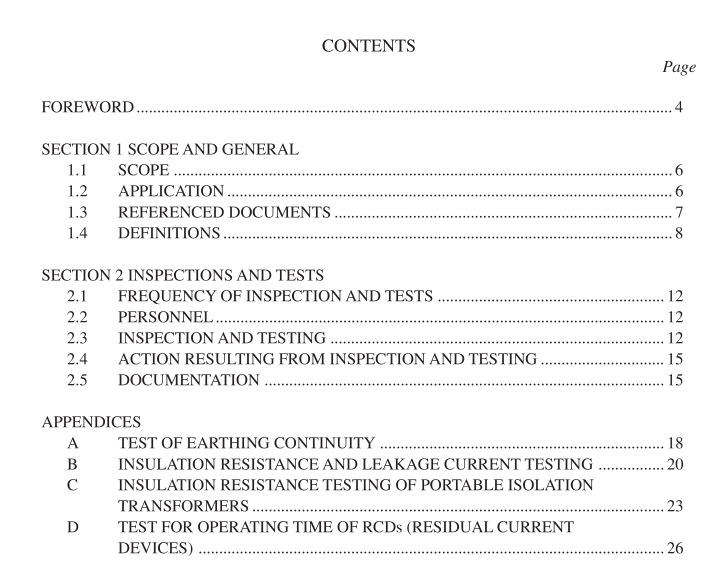AS NZS 3760 pdf download – In-service safety inspection and testing of electrical equipment

AS NZS 3760 pdf download – In-service safety inspection and testing of electrical equipment
1.4 DEFINITIONS
For the purpose of this Standard, the definitions below apply.
1.4.1 Class I equipment (basic insulated, protectively earthed equipment)
Equipment in which protection against electric shock does not rely on basic insulation only, butwhich includes an additional safety precaution, in that conductive accessible parts are connected tothe protective earthing conductor in the fixed wiring of the installation in such a way that thoseaccessible parts cannot become live in the event of a failure of the basic insulation.
NOTES:
1Class I equipment may have parts with double insulation or parts operating at safety extra-low
voltage.
2 Equipment intended for use with a flexible cord or cable includes a protective earthing conductor as
part of the flexible cord or cable.
1.4.2 Class Il equipment (double insulated equipment)
Equipment in which protection against electric shock does not rely on basic insulation only, but inwhich additional safety precautions such as double insulation or reinforced insulation are provided,there being no provision for protective earthing or reliance upon installation conditions.
This equipment is generally manufactured with a non-conductive (insulated) enclosure, and is markedeither with the words ‘DOUBLE INSULATED’ or with the symbol回to allow easy identification.
NOTE: Class Il equipment may also be manufactured with metal enclosures which are double insulatedfrom live parts.
1.4.3 Competent person
Aperson, who the person in charge of the premises ensures has acquired through training, qualification,experience or a combination of these, the knowledge and skill enabling that person to perform thetask required correctly.
1.4.4 Cord extension set (extension lead)
An assembly of a plug intended for connection to a mains outlet socket, a sheathed flexible cord anda cord extension socket.
1.4.5Electric portable outlet device (EPOD)(power board)
A device, other than a cord extension set, having a single plug intended for connection to a mainsoutlet socket, a sheathed flexible cord and an assembly of one or more outlet sockets.
It may incorporate a reeling or coiling arrangement.
1.4.6 Exposed metal
(a)A conductive part of electrical equipment which:
(i)Can be touched with the jointed test finger as specified in AS 1939; and(ii)Is not a live part but can become live if basic insulation fails.
Exposed metal parts are required to be connected to a protective earth.(b) The term exposed metal does not apply to the following:
(iLive parts.
(ii)Parts separated from live parts by double insulation or reinforced insulation, or by other
metal parts themselves earthed or having double insulation or reinforced insulation.(i) Metal nameplates, screw-heads, covers or plates, and their means of fixing, which cannot
become live in the event of failure of insulation of live parts, or, be exposed to arcingcontact with live parts.
NOTE: ‘Failure of insulation’ in this context is taken to include accidental bridging of an insulatinggap by metal or partially conducting material such as carbon dust or moisture, as well as electricalbreakdown.
(iv) Parts within an enclosure, the cover of which requires the use of a tool for its removal.
NOTE: A key is not considered to be a tool except where special circumstances prevail, e.g. theuse of the key is restricted to technical service personnel having an appropriate level ofelectrotechnical training.
(v)Parts within equipment, the configuration and mass of which are such that the parts are
not accessible during normal use and movement of the equipment.
NOTE: Non-metallic material which is conductive to a degree which may contribute to a hazardouscondition arising shall be deemed to be exposed metal, subject to the above provisions.
1.4.7 Fixed equipment
Equipment which is fastened to a support or otherwise secured in a specific location.
NOTE: Adhesives are not recognized as a means of fastening fixed equipment to a support unlessspecifically allowed in an individual Approval and Test Specification or other Standard.









